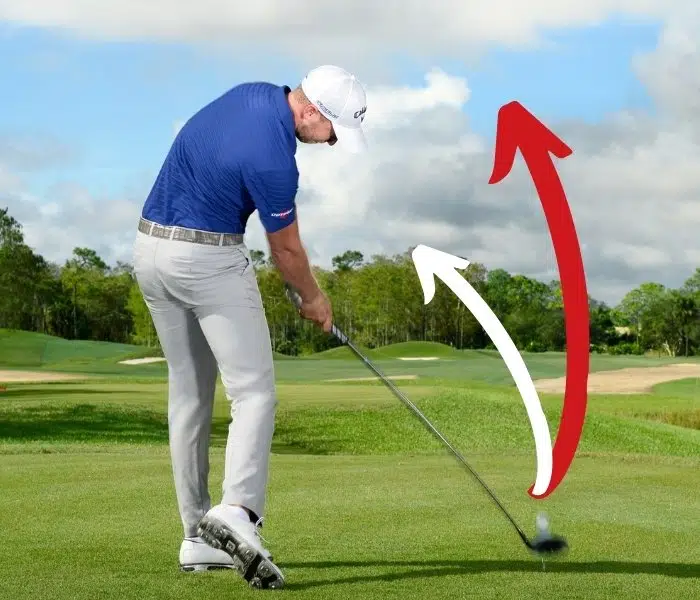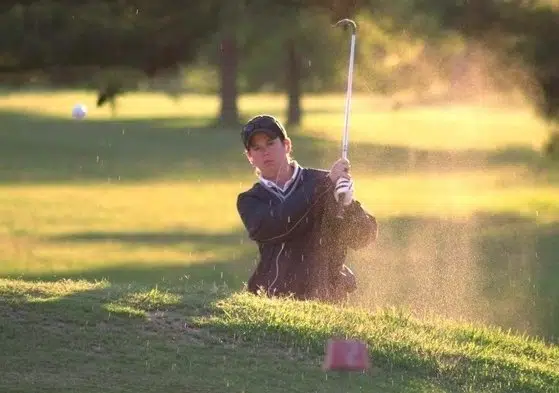Almost all golfers who break 100 for the first time immediately set their sights on breaking 90 shortly after.
You see, that’s the addictiveness of golf. It’s like a drug.
Once you taste what it’s like shooting in the 90s, you immediately want that next big high – and the only way to get it is to go even lower and register a score in the 80s.
But going from breaking 100 to breaking 90 is a lot bigger step than many amateurs realise, as the margin for error becomes a lot less.
To break 90 in golf, you only need to limit yourself to 17 bogeys and one par per round if playing 18 holes at a standard Par 72 course. Doing this requires a trusty tee game; consistent wedge play inside 100 yards/metres; and few wasted putts on the green.
Essentially, you can burn nearly one stroke every hole and still post a score of 89.
While this may sound easy enough on paper, it’s anything but when you’ve never done it before.
But, don’t fear! In this article, I’m going to share with you my own tips, tricks and learnings that have helped me create a fail-proof blueprint which, if implemented correctly, will have you breaking 90 in no time.
Note: this article assumes you have already broken 100 and have an understanding of golf’s basic fundamentals (such as grip, ball position, etc). If you haven’t yet broken 100, I recommend you read our complete guide first. You can view it here.
Table of contents
The 21 steps to breaking 90 in golf
Breaking 90 in golf requires fewer errors every hole. You also need to increase your number of fairways hit; greens in regulation; up and downs converted; and one putts made. If you can do this, you’ll lower your scores quickly and soon find yourself shooting in the 80s regularly.
I remember a time when I thought breaking 90 seemed impossible.
No matter how much I practiced, how many YouTube videos I watched, or blog articles I read, I couldn’t seem to find a way to post a score in the 80s.
I witnessed so many of my mates’ handicaps drop, while mine stayed the same, that I thought there was no way I’d ever achieve my goal.
But rather than giving up, I stuck at it and over time I began to realise which parts of my game I needed to focus most on in order to start seeing my scores come down.
Below, I’ve listed the 21 key areas that you, too, need to sharpen up on in order to break 90.
1. Arrive early and prepare before your round
If you’re serious about breaking 90, you don’t want to be cold when standing over your first tee shot of the day.
Proper preparation before a round is not only crucial for loosening up your body, but also readying your mind for the hours of golf ahead.
Your pre-game routine doesn’t have to be strenuous – there’s little gained from hitting 200 balls before playing 18 holes – but it should be enough to get you warm.
Try and arrive at the course early and make time for the following:
- Hitting some long and short putts on the practice green to get used to the slope and pace, which will help with your lag putting during your round
- Chipping a few balls around the practice green to hone your touch and hand-eye coordination (the more up and downs you can make, the better)
- Making 15-20 full swings either on a practice net or driving range (if your course has one) to get your body moving and remember the swing thoughts/feels you’ve been working on
All of this can be achieved in as little as 35-45 minutes once you get your routine down, and will give you the best possible chance of breaking 90.

2. Remember, bogeys are perfectly acceptable
Before you tee it up on the first hole, remind yourself: the goal is not to shoot even par as a mid-handicapper.
What many amateurs forget when they take to the course is that breaking 90 does not require ‘perfect golf’ – not even close.
To shoot 89, all you need are 17 bogeys and one par; if you can take that mindset into your round – and remember you have an extra shot up your sleeve on almost every hole – it will help you forget your bad shots a lot easier.
The positive flow-on effect this will have into the rest of your game cannot be underestimated.
3. Develop a pre-shot routine
Watch the pros on TV and there’s one thing they all have in common – they do exactly the same thing before every shot.
If you study footage of Tiger Woods over the years, for example, you’ll find that his putting routine has not changed a single bit.
Golf is all about repeatability; the more you can replicate the same swing or putting stroke every time you stand over the ball, the greater chance you have of producing a solid shot under pressure.
A pre-shot routine helps this tremendously by putting you in the right frame of mind and training your body to move in the same way before every swing or putt.
You can read more about the importance of developing a pre-shot routine here.
4. Get better at hitting driver
The biggest thing preventing most golfers from breaking 90 isn’t putting or chipping (despite what many pros may tell you) – it’s driving.
USGA statistics compiled from amateur players definitively shows that how far you drive the golf ball directly correlates with how low your handicap is (the longer you hit it, the lower your scores are likely to be).
Of course, accuracy is also important; but, as Bryson DeChambeau showed when employing his ‘bomb and gouge’ strategy during his 2020 US Open victory at Winged Foot, distance is equally important for going low.
There are a few ways you can improve your driver performance, as I’ve detailed below.

Get fitted correctly
I cannot stress the importance of getting fitted for a driver; if you’re going to invest a decent sum of money (drivers aren’t cheap), it makes sense you get a club that suits your swing.
Matching yourself with the correct driver at your local golf outlet can increase both your distance and accuracy without you needing to make significant changes to your swing.
You can check out our reviews of the best drivers for high handicappers here, and for seniors here.
Increase your attack angle
A big mistake many amateurs make is hitting down on the ball with their driver, which costs them distance and often accuracy.
Instead, it’s better to tee your ball higher and move it closer to the inside of your front heel; this will increase your angle of attack and launch the ball higher and longer.
This added distance, once you control it, will leave you shorter clubs into the green, which can help greatly in your pursuit of breaking 90.
Read more about attack angle here, and how you can hit your driver straighter here.
Practice regularly
This one’s a no-brainer; the more balls you hit with driver, the more confident you’ll get at using it.
Use whatever spare time you have to hit more drivers on the range, or into your practice net at home, and you’ll soon see significant improvement in your ball-striking.
If you’re feeling really adventurous, you may even like to try and harness your inner Bubba Watson by hitting a few drivers off the deck during your on-course practice sessions (after all, you never know when you might need it).
5. Find more fairways
Hitting your approach shots from the short, lush fairway as opposed to the thick rough is going to increase your number of greens in regulation and aid greatly in breaking 90.
While learning to hit driver is important, there are times that call for a more conservative, strategic approach in order to find more fairways and give yourself the best chance of landing your next shot on the putting surface.
I’ve outlined a few tips below that can help you do this.
Pick a club that suits the hole
Club selection is crucial for hitting more fairways, and the hole will often dictate which one to hit.
For example, if you’re faced with a tight landing area that runs alongside a water hazard, rather than hit driver it may be better to use a 3-wood or hybrid as they tend to be easier to control (and reduce the risk of putting your ball in the drink).
I’ve written guides on how to hit 3-wood here, and hybrid here that I recommend you read – you can also check out our review of the best hybrids available here.

Take less club if required
There are times when it’s really not worth hitting driving – short Par 4 holes are a great example of this.
Sure, hitting driver may get you closer to – or even onto – the green, but it comes with greater risk than knocking a long iron down the middle and leaving yourself a short iron or, better still, a wedge for your approach shot.
If you don’t need to hit driver, then don’t; knowing when to leave it in the bag is essential for breaking 90.
A driving iron is a fairway-finding club that many players use to help them split more fairways, and is definitely worth considering adding to your bag.
My top pick is the Srixon ZX Utility, but you can check out my full list of recommendations here.
6. Avoid OB and hazards at all costs
This one is pretty self-explanatory; if you want to break 90, you can’t afford to waste shots by blazing your ball out of bounds or into hazards.
Every time you do so, you need to play even better on the remaining holes to try and make up the lost strokes – and playing catch-up is a recipe for disaster.
When faced with water or a tight out of bounds fence, try mitigating your risk; you can do this by aiming as far as possible away from trouble, or selecting a club that won’t reach the danger area.
Sometimes it’s better to take a conservative approach and save yourself from having to use a provisional ball (and save a few dollars, too – those Titleist Pro V1s don’t come cheap!).
7. Don’t compound errors
Breaking 90 is as much about reducing the number of back-to-back poor shots as it is hitting great shots.
If you do spray your tee shot and find yourself in the trees, it can be tempting to try and pull off a miracle recovery by splitting a tiny gap between the branches.
More often than not, you’ll find yourself taking your next swing from exactly the same spot after the ball ricochets off the woodwork and lands back in front of you.
Instead, when you find yourself in trouble, choose the easiest possible route back to the fairway – even if it means pitching out directly sideways.
Playing your third shot from the short grass gives you a better chance at hitting the green in three shots and reducing the likelihood of blowing out your score.
Best-case scenario, you one-putt for par or two-putt for bogey; worst case scenario, you three-putt for double bogey and move onto the next hole (with your chances of breaking 90 still alive).

8. Play to your natural shot shape
Knowing which direction you naturally shape the ball, and not trying to fight it, is an essential tip to becoming a better player and breaking 90.
Amateurs are so often told that a draw is the ‘optimal shot shape to hit’ as it gives you extra distance; well, try telling that to Jack Nicklaus – arguably the best golfer of all time – who happened to favour a fade.
It doesn’t matter whether you prefer to hit draws or fades; what matters is that you identify which is easiest for you to execute and focus on getting really, really good at it.
Trying to fight your natural biomechanics as a mid-handicapper – all because you hear some golf commentator drooling over Rory McIlroy’s high, booming draws – will only lead to inconsistency until you’ve put in enough hours on the range to be able to hit either shot shape on command.
Until that time comes, stick to one shot shape when on the course.
Read our guides on hitting draws here, and fades here.
9. Use a rangefinder for exact yardages
If you’re already scoring in the 90s regularly, there’s a good chance you’ve gained an understanding of how far you carry each of your clubs.
To take your game to the next level and start shooting in the 80s, you need to know exactly how far you are from the pin before every shot – and to do this, you need a rangefinder.
Honestly, I can’t believe I went so long without using one; now, I find it hard to play golf without it.
The Sureshot PINLOC 5000IP is a great starter rangefinder that won’t blow your budget (read our review here).
Similarly, if you’d rather purchase something a little more ‘multi-purpose’, a GPS watch is a great alternative.
While it won’t let you zap a precise yardage, it will give you a clear number to the centre of the green thanks to in-built course data (and it’ll look great on you, too).
We recommend the Garmin Vivoactive 4 as our best all-round choice, but you can read more about other top options here (we also explain why they’re definitely worth the money).
10. Hit more greens inside 150 yards
If you’re serious about breaking 90, you can’t be wasting shots from the middle of the fairway and should be hitting the green more often than not from inside 150 yards.
Doing so increases your chances of making par and reduces the likelihood of bogey, or worse.
Improving this area of your game comes down to one simple thing: practice.
Whether it be whacking balls into your practice net at home or grinding away on the range, the only way to improve your performance with your mid/short irons is with repetition.
We’ve written some helpful articles below that can help your ball-striking:
- How to start your downswing in golf
- Clear your hips: How to get wide open in your swing
- How to maintain side bend in your swing
- Shaft lean: Get your hands forward for better contact
- How your right arm should move in your swing

11. Learn to hit knock-downs
As much as we all love playing golf in perfect weather, sometimes we’re faced with windy or rainy conditions.
A great way to control your ball in these conditions is to lower your flight by hitting what’s commonly known as a ‘knock down’.
The less time your ball spends in the air, the less opportunity the wind and rain have to send it off-line.
We’ve written some helpful guides on lowering you ball flight below:
- Lower your launch angle: How to flatten your flight
- Ball flight control: How to hit lower and higher shots
- How to play golf in the wind
- How to play golf in the rain
- How to cover the golf ball for better compression
12. Spend more time on your wedge game
A sharp wedge game is one of the next key things you need to develop if you’re serious about joining the breaking 90 club.
Yes, driver is important (as I explained earlier), but hitting the green inside 100 yards with a wedge in hand is just as crucial for shooting in the 80s.
The first secret to a great wedge game is tempo; you never want to swing all-out with a wedge as it’s a finesse club that relies on touch and feel.
The second is making sure you’re using a quality wedge with nice, sharp grooves that can impart spin on the ball and get it to stop quicker on the greens (you can check out our review of the best wedges to buy here).
Below, I’ve also listed some more articles we’re written that can improve your wedge play:
- Stop it dead: How to get backspin on your wedges
- How hard should you swing in golf? Improve tempo and accuracy
- How to be consistent at golf (build a repeatable swing)
If you can develop a reliable wedge game from inside 100 yards, you’ll give yourself more scoring opportunities and take pressure off your putter – this will reduce your chances of scoring anything worse than bogey (which is the goal when trying to break 90).
13. Get up and down more often
As a mid-handicapper, you can’t expect to hit every green in regulation – because of this, you need to learn how to get up and down more often per round if you plan on breaking 90.
‘Getting up and down’ is exactly as it sounds; chipping the ball onto the green, and then one-putting.
It may sound easy, but executing these kinds of shots under match-day pressure can be anything but, and it’s important you have a few different options in your arsenal.
Decision-making is equally important; knowing when to play a bump-and-run versus a high flop shot can be the difference between par or double bogey.
We’ve written some in-depth articles on chipping techniques below that I highly recommend you read:
- The best golf chipping techniques to master
- How to chip consistently in golf (decide to go high or low)
- Chipping vs pitching: Key differences explained
- How to play the bump-and-run in golf
If you’re someone who really struggles with getting up-and-down, consider chipping with a 7 or 8-iron as their wider soles give you a lot more forgiveness, meaning you’re less likely to thin or chunk them.
If you truly have the yips, you also might like to try using a chipper, such as the Square Strike Wedge (we’ve listed our top picks here – and yes, they’re legal).
In terms of practicing your short game, something like an at-home chipping net is a great option as it will teach you distance control, how to hit your spot, and also train you to vary how far you carry the ball in the air.

14. No careless three-putts
Everybody three-putts from time to time, even professional golfers.
However, the goal when breaking 90 is keeping them to an absolute minimum; to do this, you need to treat every putt with the exact same level of focus and concentration regardless of its length.
Too often, amateurs will let their focus lapse when faced with putts inside six feet (I’m very guilty of this), which can lead to careless misses and wasted strokes.
Tally those shots up over 18 holes and you’ll be surprised how quickly the numbers add up.
To help you become rock solid on the greens (without needing to buy a new putter), we’ve written some detailed guides focusing on all elements of putting that you’ll benefit from reading:
- Revealed: Should you wear a glove while putting?
- 7 putting grip techniques explained: But which is best?
- Putting alignment: How to line up putts correctly
- Plumb bobbing: Why it can help your putting
- How to read greens: 11 steps for success
When it boils down to it, putting comes down to practice and one of the easiest ways to do this is by using an indoor putting mat at home, like the TruBirdie Putting Green (we’ve listed our top picks here).
Training aids can also help fine-tune your stroke and can be great additions to your warm-up routine before a game – we’ve detailed our favourite putting aids here.
15. Use quality golf balls
If you want more control of your golf ball (which you should if you’re serious about breaking 90) you can’t be using rocks on the course.
While they may be a little more expensive, it’s time you upgraded to a better brand suited to a mid-handicapper – ideally, one with a three-piece composition and urethane cover.
This will give you a lot more responsiveness and feel, particularly around the greens, compared to balls that use a two-piece design with a surlyn exterior.
Personally, I find the Callaway Chrome Soft to be the best ball for amateurs, while the TaylorMade Project (a), TaylorMade Pix and Bridgestone BXS balls are also great choices (I’ve used all of them and have nothing but praise for each).
Of course, you can always grab yourself a deck of Titleist Pro V1x balls if you’ve got some cash to splash.
We’ve also listed some more budget-friendly options here if you’d rather not break the bank (however, they are more geared towards high handicappers).
16. Track your strengths and weaknesses
If you want to break 90, then you need to know what your strengths and weaknesses are.
Yes, most amateurs will be able to tell you what they perceive to be their shortfalls, but it’s unlikely they’d be able to produce any data to back it up.
How many fairways did they hit? When they missed the fairway, was it to the left or right? How many greens in regulation did they make? How many times did they get up and down? How many putts did they have?
Without recording this data, it’s hard to know what areas of your game are solid, and what areas need improvement.
Many golf GPS watches come with apps that will allow you to input the above statistics during your round, allowing you to clearly decide what to dedicate your practice to (whether it’s putting, chipping or driving).
If you don’t have a golf watch, and have no interest in buying one, you can easily jot these stats down on your scorecard as you go.

17. Develop a clear strategy
If you have a clear strategy heading into your round, it’s far more likely that you’ll stick to it when things start going awry on the course than if you’re making it up as you go.
There are a few things you can do to think your way around the golf course, which will certainly help in your pursuit of breaking 90.
Play the hole backwards
One way to decide what club to hit off the tee is to first decide what club you’d like to have into the green.
For example, if your 9-iron is your favourite club and you know you hit it 135 yards, subtract that number from the total length of the hole and that will determine which club you tee off with.
So, on a 350-yard Par 4, you should hit a club that travels 215 yards (which for many players may be less than driver).
Don’t be afraid to play Par 5s in three shots
The same approach can be applied to Par 5s.
Many amateurs think they need to reach the green in two shots, which is simply not the case when trying to break 90.
If you wish to hit your 135-yard 9-iron into the green, then subtract that yardage from the total length of the hole, then divide it by two – this will give you the club you need to hit off the tee, then from the fairway for your second shot.
So, for a 505-yard hole, you may hit two 185-yard 5-irons, then your 9-iron.
Experiment with tee shots
Most semi-serious golfers will have a home course that they’re members of, and play at regularly.
The advantage of this is you have a great opportunity to experiment with different clubs for your tee shots over many rounds, and develop a clear strategy for how you approach each hole.
Over time, you’ll know exactly what club you need to hit on every tee block (baring any excessive wind, which will alter your calculations), and reducing this on-the-fly decision-making removes indecision and improves your confidence.
18. Control your emotions
We all play bad shots during a round, regardless of whether you’re an amateur or a pro – but it’s how you bounce back from them that will help determine whether you break 90 or not.
Of course, everyone is different; American Dustin Johnson barely cracks a smile on the course no matter how well/not well he’s playing, while Englishman Tyrell Hatton has some incredible blow-ups when things aren’t going his way.
But if you look at most professional golfers, they’re very good at controlling their emotions and keeping a level head.
If you hit a bad shot, try the following before hitting your next one:
- Take a deep breath
- Clear your mind of all negative thoughts
- Go through your pre-shot routine
- Make your swing/putt
Not getting hung up on bad swings or putts is essential to avoid compounding errors – if you can control your emotions, you’ll be able to play every shot with a clear head, which gives you a better chance of achieving a good result.

19. Consider getting lessons
Some people swear by golf lessons, some people don’t like getting them – personally, I found lessons beneficial once I found the right golf instructor.
I was able to shave six shots off my handicap in just 10 weeks after getting regular lessons, and I definitely recommend you at least give them a try if you’re struggling to break 90.
Make sure your instructor uses some sort of ball-tracking technology, such as FlightScope or TrackMan, so that they can analyse the data and tell you exactly what your swing is doing (and how you can improve it).
20. Record your swing
If you can’t afford a lesson, or would prefer to go it alone, then recording your swing is one way to analyse whether you’re shallowing the club too much, coming over-the-top or delivering the club on plane.
All you need is a tri-pod with a smartphone attachment and you’re good to go (we’ve detailed exactly how to film your swing here).
However, this approach does come with a warning – without a professional teacher present, you really are flying blind in terms of how to fix deficiencies in your swing and run the risk of making things worse, rather than better.
But, if you are determined to figure things out on your own, I’d suggest you watch some videos of the best golfers in the world, and try to copy their movements as best as possible.
As the saying goes: imitation is the best form of flattery.
21. Spend more time practicing on-course
While bashing balls on the driving range can certainly improve your game, nothing beats on-course practice.
Sure, it’s easy to pump drives down the wide-open range, but put a tight fairway and trees in front of you and suddenly things become a little harder.
Practicing on the course can benefit you in ways the range never will, such as:
- Teaching you to execute tee shots under pressure
- Allowing you to hit balls off real grass, rather than mats
- Helping you read greens and practice your short game
- Teaching you to hit to a spot and use course management
I’ve always found on-course practice to be much more productive than range practice, as you can play a few balls each hole and practice a variety of full swings, chips and putts in a match-like situation.
If you can’t get to the course, or even the range, we’ve also written an article explaining some ways you can practice at home here.
Other Frequently Asked Questions (FAQs)
What percentage of golfers can break 90?
Anywhere between 16.5 and 31.9 percent of male golfers will never break 90, based on their average handicaps. For women, as much as 71 percent of players will never break 90 based on their average handicaps.
Golfing Focus have provided an easy breakdown of the percentage of golfers in the 20+ handicap bracket in the United States, Australia and United Kingdom (which, when applied to a Par 72 course would be in excess of 89 strokes per round):
Australia
- Male golfers with a 20+ handicap: 30.5 percent
- Female golfers with a 20+ handicap: 73.6 percent
United States
- Male golfers with a 20+ handicap: 16.5 percent
- Female golfers with a 20+ handicap: 71.1 percent
United Kingdom
- Male golfers with a 20+ handicap: 31.9 percent
- Female golfers with a 20+ handicap: 75.1 percent
Is it hard to break 90 in golf?
Breaking 90 isn’t easy, but it’s achievable if you can fine-tune the key aspects of your game such as driving, chipping and putting. Shooting in the 90s requires you to minimise careless errors and concentrate fully during your entire round. If you can do this, breaking 90 isn’t as hard as it might seem.
If you’ve been stuck in the 90s for a long time, breaking into the 80s can seem like an impossible task – however, by applying yourself during practice at least once a week (even more, if time permits), it won’t be long until you achieve your goal.
As I’ve outlined in this article, breaking 90 can’t be achieved by just one or two swing changes – it takes a complete change in mindset and clear approach to course management, coupled with strengthening the weaknesses in your game, to accomplish it.
How long does it take to break 90 in golf?
While most golfers will break 90 at some point in their lives, provided they play the game long enough, there are still a significant number of players who never will. How long it takes you to break 90 comes down to how committed you are to practice, and whether you can implement good course management during your round.
As the old adage goes: you only get out what you put in.
Unless you’re a naturally gifted sportsperson who can pick up new skills quickly, the reality is that breaking 90 in golf requires a lot of time and effort.
Shooting in the 80s – for most people – doesn’t just happen.
It requires spending many hours at the range, chipping area, putting green or practicing at home in order to fine-tune your skills, so that you can execute them under pressure when out on the golf course.
The more time you dedicate to improving your game, the quicker you will break 90.
Final message
Breaking 90 is the next big milestone in your golfing journey, once breaking 100 has been ticked off the list.
While the extra 10 shots may not seem like much, shooting in the 80s compared to the 90s takes a lot more effort and commitment in order to achieve.
It also requires you to think more strategically when on the course: what club is best suited to this hole? How can I avoid trouble? Do I really need to hit driver on this tight fairway?
Thinking of correct answers to these questions during your round will help you make better decisions that reduce your chances of blow-up holes.
Doing this, coupled with tidying up your long game and short game, is the real key to breaking 90.


